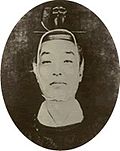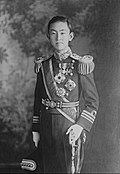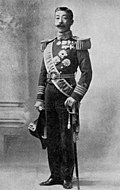Ōke
Ōke
Branches of the Japanese Imperial Family
The Kyū-Miyake (旧宮家, "former Miyake"), also known as the Old Imperial Family (旧皇族), were branches of the Japanese Imperial Family created from branches of the Fushimi-no-miya house, the last surviving Shinnōke cadet branch. All but one (the Nashimoto-no-miya) of these ōke (王家) were formed by the descendants of Prince Fushimi Kuniie. The ōke were stripped of their membership in the Imperial Family by the American Occupation Authorities in October 1947, as part of the abolition of 11 collateral branches (imperial houses) with 51 members.[1] After that point, only the immediate family of Emperor Shōwa and those of his three brothers retained membership in the Imperial Family. However, unofficial heads of these collateral families still exist for most and are listed herein.
In recent years, conservatives have proposed to reinstate several of the former imperial branches or else to allow the imperial family to adopt male members of the former princely houses, as a solution to the Japanese succession controversy.
The kyū-miyake were, in order of founding:
- Nashimoto (梨本) - extinct in 1951
- Kuni (久邇)
- Yamashina (山階) - extinct in 1987
- Kachō (華頂) - extinct in 1924
- Kitashirakawa (北白川) - extinct in 2018
- Higashifushimi or Komatsu (東伏見 / 小松) - extinct in 1922
- Kaya (賀陽)
- Asaka (朝香)
- Higashikuni (東久邇)
- Takeda (竹田)
Unless otherwise stated, all princes listed herein are the sons of their predecessor.
Nashimoto-no-miya
The Nashimoto-no-miya house was formed by Prince Moriosa, son of Prince Fushimi Sadayoshi (father of Prince Fushimi Kuniye)
| Name | Born | Succeeded | Retired | Died | Notes | |
|---|---|---|---|---|---|---|
| 1 | Prince Nashimoto Moriosa (梨本宮 守脩親王, Nashimoto-no-miya Moriosa-shinnō) | 1819 | 1870 | 1885 | ||
| 2 | Prince Nashimoto Kikumaro (山階宮菊麿王, Nashimoto-no-miya Kikumaro-ō) | 1873 | 1885 | 1885 | 1908 | grand-nephew of Moriosa; resigned to return to the Yamashina household |
| 3 | Prince Nashimoto Morimasa (梨本宮守正王, Nashimoto-no-miya Morimasa-ō) | 1874 | 1885 | 1947 | 1951 | cousin of Kikumaro and fourth son of Kuni-no-miya Asahiko |
Kuni-no-miya
The Kuni-no-miya house was formed by Prince Asahiko, fourth son of Prince Fushimi Kuniye
| Name | Born | Succeeded | Retired | Died | Notes | |
|---|---|---|---|---|---|---|
| 1 | Prince Kuni Asahiko (久邇宮 朝彦親王, Kuni-no-miya Asahiko shinnō) | 1824 | 1863 | 1891 | became shinnō in 1871 | |
| 2 | Prince Kuni Kuniyoshi (久邇宮 邦彦王, Kuni-no-miya Kuniyoshi ō) | 1873 | 1891 | 1929 | father of Empress Kojun | |
| 3 | Prince Kuni Asaakira (久邇宮 朝融王, Kuni-no-miya Asaakira ō) | 1901 | 1929 | 1947 | 1959 | |
| 4 | Kuni Kuniaki (久邇 邦昭) | 1929 | 1959 | |||
Yamashina-no-miya

The Yamashina-no-miya house was formed by Prince Akira, eldest son of Prince Fushimi Kuniye.
| Name | Born | Succeeded | Retired | Died | Notes | |
|---|---|---|---|---|---|---|
| 1 | Prince Yamashina Akira (山階宮 晃親王, Yamashina-no-miya Akira shinnō) | 1816 | 1864 | 1898 | ||
| 2 | Prince Yamashina Kikumaro (山階宮 菊麿王, Yamashina-no-miya Kikumaro-ō) | 1873 | 1898 | 1908 | ||
| 3 | Prince Yamashina Takehiko (山階宮 武彦王, Yamashina-no-miya Takehito-ō) | 1898 | 1908 | 1947 | 1987 | |
The Yamashina-no-miya became extinct with the death of Yamashina Takehiko.
Kachō-no-miya
The Kachō-no-miya house was formed by Prince Hirotsune, son of Prince Fushimi Kuniye.
| Name | Born | Succeeded | Retired | Died | Notes | |
|---|---|---|---|---|---|---|
| 1 | Prince Kachō Hirotsune (華頂宮博経親王, Kachō-no-miya Hirotsune-shinnō) | 1851 | 1868 | 1876 | ||
| 2 | Prince Kachō Hiroatsu (華頂宮博厚親王, Kachō-no-miya Hiroatsu-shinnō) | 1875 | 1876 | 1883 | ||
| 3 | Prince Kachō Hiroyasu (華頂宮博恭親王, Kachō-no-miya Hiroyasu-shinnō) | 1875 | 1883 | 1904 | 1946 | |
| 4 | Prince Kachō Hirotada (華頂宮博忠王, Kachō-no-miya Hirotada-ō) | 1902 | 1904 | 1924 | ||
| X | Marquis Kachō Hironobu (華頂博信, Kachō Hironobu) | 1905 | 1924 | 1947 | 1970 | |
The Kachō-no-miya became extinct with the death of Prince Kachō Hirotada. The line of descent was continued through the kazoku peerage under Kachō Hironobu.
Kitashirakawa-no-miya
The Kitashirakawa-no-miya house was formed by Prince Satonari, thirteenth son of Prince Fushimi Kuniye.
| Name | Born | Succeeded | Retired | Died | Notes | |
|---|---|---|---|---|---|---|
| 1 | Prince Kitashirakawa Satonari (北白川宮 智成親王, Kitashirakawa-no-miya Satonari shinnō) | 1844 | 1872 | 1872 | ||
| 2 | Prince Kitashirakawa Yoshihisa (北白川宮 能久親王, Kitashirakawa-no-miya Yoshihisa-shinnō) | 1847 | 1872 | 1895 | brother of above | |
| 3 | Prince Kitashirakawa Naruhisa (北白川宮 成久王, Kitashirakawa-no-miya Naruhisa-ō) | 1887 | 1895 | 1923 | ||
| 4 | Prince Kitashirakawa Nagahisa (北白川宮 永久王, Kitashirakawa-no-miya Nagahisa-ō) | 1910 | 1923 | 1940 | ||
| 5 | Prince Kitashirakawa Michihisa (北白川宮 道久王, Kitashirakawa-no-miya Michihisa-ō) | 1937 | 1940 | 1947 | 2018 | Kitashirakawa Michihisa after 1947 |
The Kitashirakawa-no-miya became extinct with the death of Kitashirakawa Michihisa without heirs on 20 October 2018.[2]
Higashifushimi-no-miya / Komatsu-no-miya
The Higashifushimi-no-miya or the Komatsu-no-miya house was formed by Prince Yoshiaki, seventh son of Prince Fushimi Kuniye.
| Name | Born | Succeeded | Retired | Died | Notes | |
|---|---|---|---|---|---|---|
| 1 | Prince Higashifushimi Yoshiaki (東伏見宮 嘉彰親王, Higashifushimi no miya Yoshiaki-shinnō) Prince Komatsu Akihito (小松宮 彰仁親王, Komatsu-no-miya Akihito-shinnō) | 1846 | 1867 1872 | 1872 | 1903 | changed name in 1872 |
| 2 | Prince Higashifushimi Yorihito (東伏見宮 依仁親王, Higashifushimi no miya Yorihito-ō) | 1876 | 1903 | 1922 | brother of Akihito reverted name back to Higashifushimi | |
In 1931, Emperor Shōwa directed his brother-in-law, Prince Kuni Kunihide, to leave Imperial Family status and become Count Higashifushimi Kunihide (hakushaku under the kazoku peerage system), to prevent the Higashifushimi name from extinction. Dowager Princess Higashifushimi Kaneko became a commoner on 14 October 1947. She died in Tokyo in 1955.
Kaya-no-miya
The Kaya-no-miya house was formed by Prince Kuninori, second son of Prince Kuni Asahiko (first Kuni-no-miya, see above)
| Name | Born | Succeeded | Retired | Died | Notes | |
|---|---|---|---|---|---|---|
| 1 | Prince Kaya Kuninori (賀陽宮 邦憲王, Kaya-no-miya Kuninori shinnō) | 1867 | 1896 | 1909 | Kaya-no-miya was a personal title until 1900 | |
| 2 | Prince Kaya Tsunenori (賀陽宮 恒憲王, Kaya-no-miya Tsunenori-ō) | 1900 | 1909 | 1947 | 1978 | Kaya Tsunenori after 1947 |
| 3 | Kaya Kuninaga (賀陽宮 信彦王) | 1922 | 1978 | 1986 | politician; died without heirs. | |
| 4 | Kaya Harunori (賀陽 治憲) | 1926 | 1987 | 2011 | brother of Kuninaga; career diplomat; died without heirs. | |
| 5 | Kaya Masanori (賀陽 文憲) | 1959 | 2011 | nephew of Harunori through his younger brother Akinori; career diplomat; with male issue. | ||
Asaka-no-miya

The Asaka-no-miya house was formed by Prince Yasuhiko, eighth son of Prince Kuni Asahiko.
| Name | Born | Succeeded | Retired | Died | Notes | |
|---|---|---|---|---|---|---|
| 1 | Prince Asaka Yasuhiko (朝香宮 鳩彦王, Asaka-no-miya Yasuhiko-ō) | 1887 | 1906 | 1947 | 1981 | |
| X | Asaka Takahiko | 1912 | 1981 | 1994 | ||
| X | Asaka Tomohiko | 1944 | 1994 | |||
Higashikuni-no-miya
The Higashikuni-no-miya house was formed by Prince Naruhiko, ninth son of Prince Kuni Asahiko.
| Name | Born | Succeeded | Retired | Died | Notes | |
|---|---|---|---|---|---|---|
| 1 | Prince Higashikuni Naruhiko (東久邇宮 稔彦王, Higashikuni-no-miya Naruhiko-ō) | 1887 | 1906 | 1947 | 1990 | Prime Minister of Japan (17 August 1945 – 9 October 1945) |
| X | Prince Higashikuni Morihiro (東久邇宮 盛厚王, Higashikuni no miya Morihiro ō) | 1916 | 1947 | 1969 | ||
| 2 | Prince Higashikuni Nobuhiko (東久邇宮 信彦王, Higashikuni-no-miya Nobuhiko-ō) | 1945 | 1990 | 2019 | grandson of Naruhiko, son of Morihiro | |
| X | Higashikuni Yukihiko (東久邇征彦, Higashikuni Yukihiko) | 1973 | 2019 | son of Nobuhiko | ||
Prince Higashikuni Nobuhiko became simply "Higashikuni Nobuhiko" after the abolition of the Japanese aristocracy during the American occupation of Japan in 1947.
Takeda-no-miya
The Takeda-no-miya house was formed by Prince Tsunehisa, eldest son of Prince Kitashirakawa Yoshihisa (second Kitashirakawa-no-miya).
| Name | Born | Succeeded | Retired | Died | Notes | |
|---|---|---|---|---|---|---|
| 1 | Prince Takeda Tsunehisa (竹田宮 恒久王, Takeda-no-miya Tsunehisa-ō) | 1882 | 1906 | 1919 | ||
| 2 | Prince Takeda Tsuneyoshi (竹田宮 恒徳王, Takeda-no-miya Tsuneyoshi-ō) | 1909 | 1919 | 1947 | 1992 | |
| 3 | Prince Takeda Tsunetada (竹田 恒正, Takeda-no-miya Tsunetada-ō) | 1940 | 1992 | |||
This section needs to be updated. (September 2017) |
In January 2005, Prime Minister Junichiro Koizumi set up a panel consisting of 10 experts from various fields to discuss the succession law and possible ways to ensure stable succession in the imperial family. At that point, no male heir had been born to the Imperial family in 40 years, prompting concerns that there wouldn't be anyone to succeed Crown Prince Naruhito after he became emperor. The panel recommended giving eligibility to females and their descendants, that the first child, regardless of sex, be given priority in ascension, and that female family members who marry commoners be allowed to retain their imperial family member status. Itsuo Sonobe, deputy chairman of the 10-member government panel and a former Supreme Court justice, said that one of the panel's main concerns had been to find a solution that would win the people's support.[3]
Media opinion polls showed an overwhelming majority favoring the change, but the proposed revision was met with fierce opposition from conservatives, who held that the imperial dynasty, which had survived in an unbroken line stretching for nearly 2700 years, could not be dismissed and ended by a wave of deracinated modernity and uncaring recentism. They proposed instead that the government take recourse to ancient traditions under which such situations had been handled in the past. They pointed out that various branches of the old imperial family do still exist in Japan, and that the constitutional definition of the "imperial family" which prevails today was imposed by the occupying western forces as recently as 1947. They maintained that, rather than ending the ancient imperial dynasty, it would be more sensible and less radical to end the recent, western-imposed restrictions. Tsuneyasu Takeda [jp], a member of the former Takeda-no-miya collateral house (nephew of the current family head Tsunetada Takeda [jp] and son of Tsunekazu Takeda) and author of a book entitled The Untold Truth of Imperial Family Members, proposed to maintain the male line by restoring the former princely houses or by allowing imperial family members to adopt males from those families. Although Takeda has written that such men should feel a responsibility to maintain the royal house, he said he would find it daunting if asked to play that role himself.[4] According to Takeda, the heads of the former court families agreed in late 2004, just before Koizumi's advisory panel started its discussions, not to speak out on the issue and some of them told him to "not get involved in political issues".[5] Opponents of the reinstatement of former collateral branches, like Liberal Democratic Party politician Yōichi Masuzoe, argued that it would favor members of families with tenuous blood links to long-ago emperors over contemporary female descendants of recent sovereigns.[6]
During a series of hearings on the succession problem in early 2012, Yoshiko Sakurai and Akira Momochi, conservative members of the panel of experts, rejected proposals for female members of the imperial family to be allowed to retain their royal status after marriage and create new branches of the imperial family, and instead suggested revising the Imperial Household Law so that male descendants of former imperial families which renounced their royal status in 1947 be allowed to return to the imperial family as adoptees.[7] Another proposal was to reinstate four of the former imperial families,[8] a solution opposed by the government on the grounds that it would not enjoy public support.[9] Government sources told the Yomiuri Shimbun in May 2012 that the suggestion to reinstate men from the former princely houses as imperial family members through adoption had been unexpected.[10]
In September 2021, it was considered to amend the Imperial Household Law and allow the 85-year old Prince Hitachi to adopt a male member of the collateral branches of the imperial family.[11]
- Saitō Katsuhisa (June 20, 2022). "Royal Reduction: The Postwar Downsizing of Japan's Imperial Family". Nippon.com. Archived from the original on June 20, 2022.
- "元皇族の北白川道久氏死去" [Former Imperial Family Member Michihisa Kitashirakawa Has Died]. Jiji Press (in Japanese). 22 October 2018. Archived from the original on 22 October 2018. Retrieved 16 February 2020.
- Onishi, Norimitsu (December 27, 2005). "What Japan's Aiko Lacks: The Royal Y Chromosome". The New York Times.
- "Male-Only Imperial Line Backed". Gulf Daily News. February 17, 2006.
- "2 experts at gov't hearing oppose creating female imperial branches". The Mainichi. April 11, 2012.
- Warnock, Eleanor (April 11, 2012). "Japanese Journalist Weighs in on the Princess Problem". The Wall Street Journal.
- Takeshi Okamura and Katsumi Takahashi (March 2, 2012). "Imperial Family Talks Begin: Should Female Members Retain Royal Status after Marriage?". The Daily Yomiuri.
- Yutaka Ito, Katsumi Takahashi and Takeshi Okimura (May 4, 2012). "Imperial Revision Draft Set for Autumn Release". The Daily Yomiuri.
- Tokyo, Richard Lloyd Parry. "Adopted sons tipped to stave off Japan's imperial succession crisis". The Times. Retrieved September 30, 2021.
- Fujitani, T. Splendid Monarchy: Power and Pageantry in Modern Japan. University of California Press; Reprint edition (1998). ISBN 0-520-21371-8
- Lebra, Sugiyama Takie. Above the Clouds: Status Culture of the Modern Japanese Nobility. University of California Press (1995). ISBN 0-520-07602-8
- Japan's "Princess Problem" – Website The Royal Universe
![]() Media related to Ōke at Wikimedia Commons
Media related to Ōke at Wikimedia Commons















